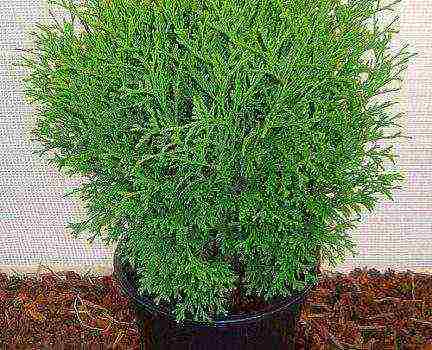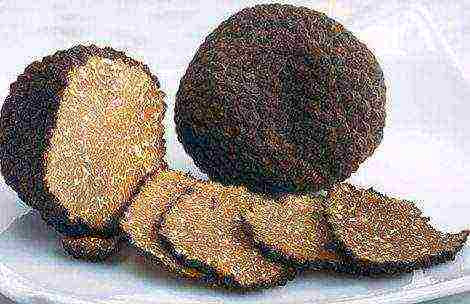Content [show]
The spectacular juniper (Juniperus) is an evergreen (tree or shrub) of the Cypress family (Cupressaceae). In the wild, its growth is noted throughout the entire Northern Hemisphere (from polar to tropical regions).
Juniper varieties suitable for home cultivation
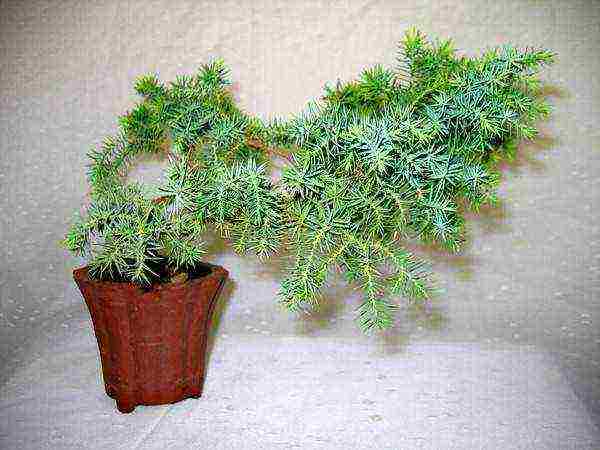 There are many types of juniper, on the basis of which scientists have developed many varieties suitable for growing at home. Having planted this plant in a flowerpot, providing it with proper care, you can count on getting a beautiful tree or bush, which is guaranteed to give a kind of "zest" to any interior.
There are many types of juniper, on the basis of which scientists have developed many varieties suitable for growing at home. Having planted this plant in a flowerpot, providing it with proper care, you can count on getting a beautiful tree or bush, which is guaranteed to give a kind of "zest" to any interior.
The most popular are the Chinese juniper (Juniperuschinensis) and the hard juniper (Juniperus rigida). Under natural conditions, they are capable of reaching significant heights. Indoors, these types of indoor juniper, varieties bred on their basis, planted in pots, show slow growth rates. Providing the recommended temperature and humidity regime, such plants will feel very good at home. You can read the article about Andorra Variegata juniper.
Conditions for home growing juniper
As practice shows, it is not so difficult to grow a magnificent juniper indoors. The main thing is to create the most suitable microclimate for it. The greatest danger to the plant is the hot, dry indoor air.
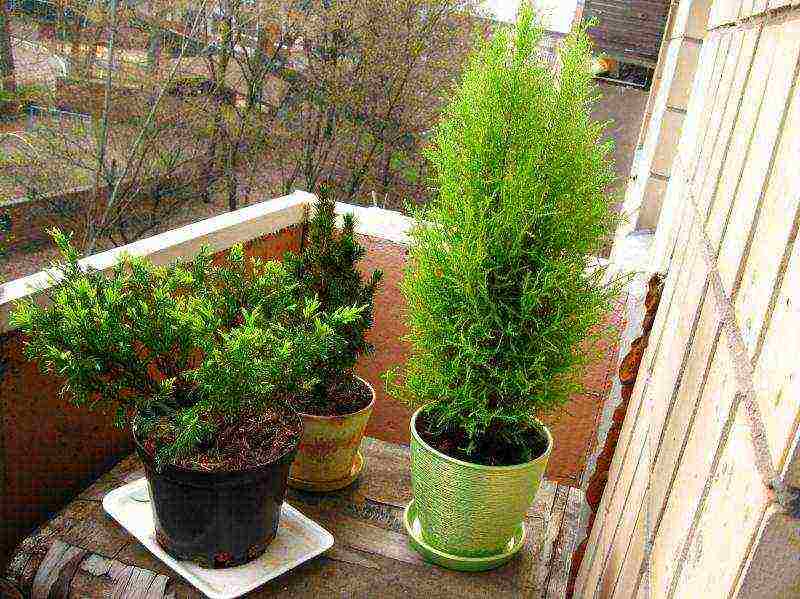 Recommended plant lighting
Recommended plant lighting
Having planted an indoor juniper, you need to immediately provide it with the correct lighting. The plant likes light, but it needs protection from the direct rays of the sun. A bush that grows in the shade in summer and in the sun in winter can die. To prevent this, in the cold season, it is advisable to expose a pot of juniper on a south-facing window. In the warm season, the plant needs to equip the shading and define it on the northern windowsill.
Temperature regime for culture
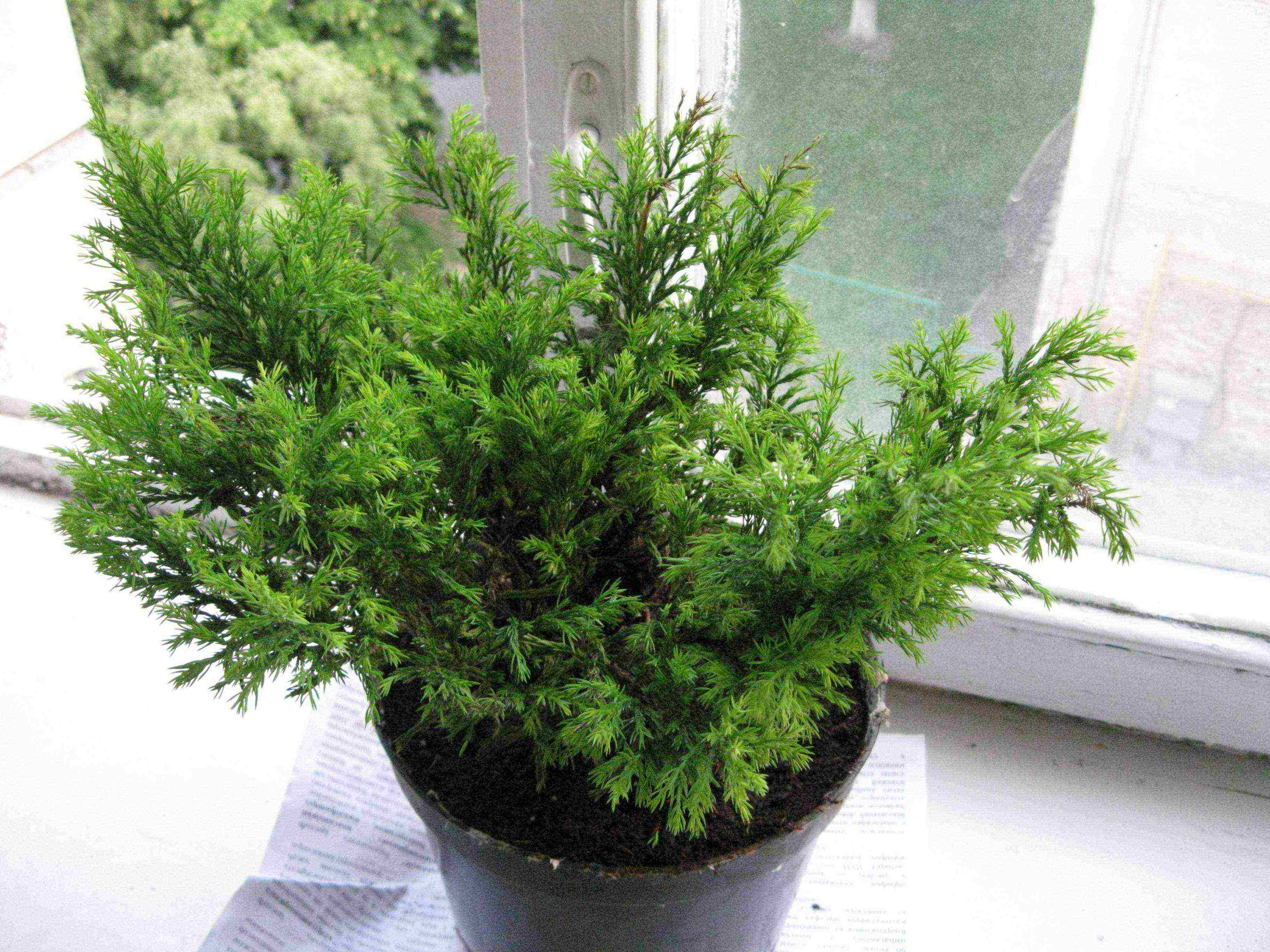 Evergreen juniper - many people strive to grow a houseplant. To be guaranteed to succeed, you will need to pay attention to creating a comfortable temperature regime.
Evergreen juniper - many people strive to grow a houseplant. To be guaranteed to succeed, you will need to pay attention to creating a comfortable temperature regime.
It is very important to exclude overheating of the air. The recommended temperature values should not exceed + 20 ° C. At the same time, the bush reacts negatively to excessive hypothermia. In winter, it is necessary to control temperature fluctuations, the values of which are below + 13 ° C can negatively affect the health of the plant.
In the summertime, taking out the flowerpot to the balcony or street is encouraged.It should be taken into account that the home juniper, which loves fresh air, reacts negatively to drafts.
The choice of planting capacity
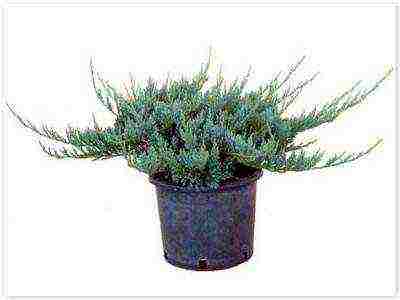 The pot provided to the bush should be free enough, since members of the Cypress family grow well if their root system has enough room for development. It will be mandatory to arrange a drainage layer (broken brick, gravel, expanded clay) at the bottom of the planting container.
The pot provided to the bush should be free enough, since members of the Cypress family grow well if their root system has enough room for development. It will be mandatory to arrange a drainage layer (broken brick, gravel, expanded clay) at the bottom of the planting container.
The choice of containers for the manufacture of which natural materials are used is welcomed: ceramics, clay, porcelain. In addition, it is worth paying attention to the shape of the flowerpot, the presence of a beautiful pattern on its surface, in harmony with the appearance of the plant.
Soil quality requirements
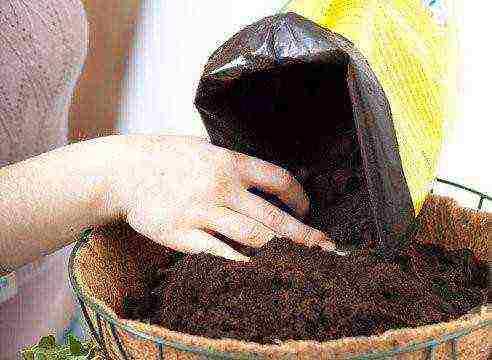 Juniper at home in a pot will grow best in a planting container filled with porous soil. This will ensure uniform access of moisture to the root system.
Juniper at home in a pot will grow best in a planting container filled with porous soil. This will ensure uniform access of moisture to the root system.
Despite the prevailing opinion that this representative of the Cypress family is undemanding to the quality of the soil, it is necessary to give preference to planting it in a soil mixture with the following composition: sod land, sand, peat. The addition of nitrophoska or any other universal fertilizer purchased in a specialized store to the soil is also encouraged.
Reproduction of juniper: basic methods
The most widespread are two methods of reproduction of juniper: the seed method, as well as cuttings. Each of them has its own nuances, advantages and disadvantages.
Seed breeding method
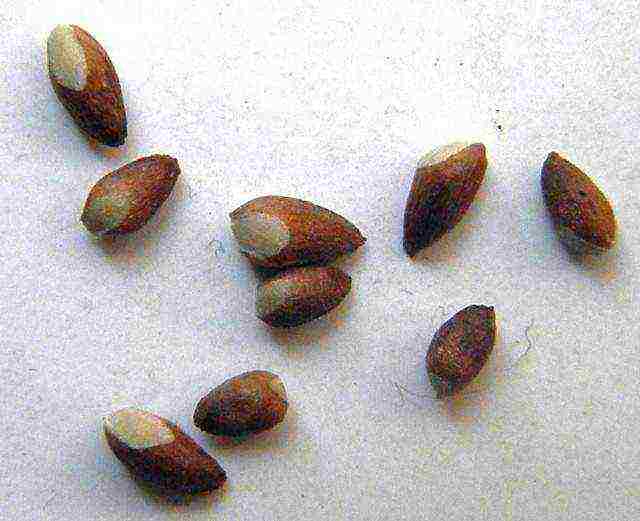 When studying information on how to propagate a juniper at home using seeds, you need to take into account the low efficiency of such a procedure due to the poor germination of planting material. In most cases, this method is the choice of breeders.
When studying information on how to propagate a juniper at home using seeds, you need to take into account the low efficiency of such a procedure due to the poor germination of planting material. In most cases, this method is the choice of breeders.
Having decided to breed juniper from seeds at home, it is advisable to hold this event in the fall. As a container, it is worth choosing boxes that are taken out into the street during the cold season and left for 4 months in the open air. The preserved hardened seeds are planted in pots at the end of spring.
The containers are placed in a well-lit place. Seedlings need timely watering, which prevents the soil from drying out. You can count on the emergence of seedlings next year.
Cutting indoor juniper
 Compared to the method described above, propagation of a juniper by cuttings is easier. Plants that are at least 8 years old should be used as "donors".
Compared to the method described above, propagation of a juniper by cuttings is easier. Plants that are at least 8 years old should be used as "donors".
Cuttings about 10 cm long are cut in the spring. Next, they will need to be placed in a mixture of sand and peat. The container with cuttings is installed in a shaded place, covered with a film. The seedlings are constantly sprayed. After 2 months, roots are formed. Fortified, rooted specimens are transplanted into flowerpots.
Planting juniper in a pot
Having decided to plant a juniper in a pot, you need to make a hole in the ground in advance, the depth of which will be 2 times the height of the bush. It is best to use planting specimens with roots covered with a layer of soil.
The seedling is positioned in such a way that the top of the root earthen coma is 8 cm above the bottom of the soil excavation. When filling the hole with soil, you will need to gently hold the plant. Next, a careful compaction of the upper layer of soil is carried out, and it is sprinkled with a mulch layer of peat or humus.
Juniper care
Competently organized care of indoor juniper implies compliance with certain rules. The tips below will surely help you avoid many annoying mistakes.
Watering and spraying the plant
It is worth noting that moderate watering is recommended for junipers. In the summer, the soil in the flowerpot is moistened every two days after the drying of the top layer of the soil is revealed.In the cold season, the irrigation procedure is carried out twice a month.
The main condition is to prevent the land from drying out. You will need to make sure that the soil in the pot does not dry out, be sure to drain excess moisture from the pallet. In addition, it is necessary to spray the plant (in summer - every day, in winter every other day).
Carrying out fertilizing for the culture
When growing a juniper at home, you will need to feed it every 14 days during the period of its active growth (April - September). For this purpose, organic matter is added to the water used for irrigation. The use of humus has proven itself well. But for the introduction of mineral complexes, it should be done in very small doses.
Juniper pruning procedure
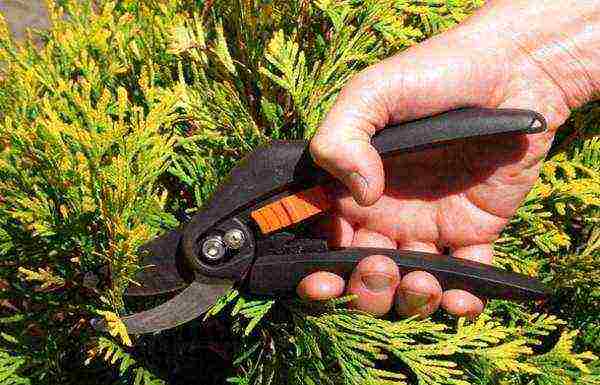 A growing juniper at home needs annual pruning, which ensures that it remains compact. As a rule, this event takes place in February. This procedure involves the removal of deformed, dried branches.
A growing juniper at home needs annual pruning, which ensures that it remains compact. As a rule, this event takes place in February. This procedure involves the removal of deformed, dried branches.
In order to form a plant, young shoots, the apical part, are pruned. This will contribute to giving the bush the necessary splendor, original shape (pyramid, cone), strengthening its health.
Transplanting a plant into another pot
Young decorative juniper is transplanted annually.
 The optimal period for such an event is spring (mid-March). It is very important that the height of the plant does not exceed 1 m.
The optimal period for such an event is spring (mid-March). It is very important that the height of the plant does not exceed 1 m.
Initially, you will need, using a garden shovel, to carefully separate the soil in the area of \ u200b \ u200bthe walls (with the deepening of the tool to the middle of the pot). Next, you should remove the bush, gently holding it at the base, with a lump of earth. It is then placed in a new pot (in the prepared hole in the soil).
The dug hole should be twice the size of the earthen root ball. At the end of the procedure, the resulting voids in the recess are backfilled, and the soil is carefully tamped. The surface of the earth is covered with peat, crushed by the bark of a coniferous tree. The plant is watered.
Wintering juniper at home
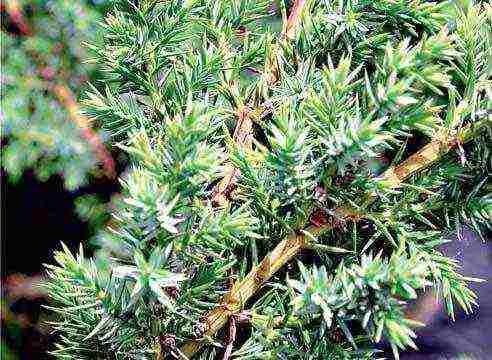 Winter care at home for a juniper has its own specifics. It should be noted that the plant is contraindicated to be near central heating devices. It is best to place the pot on a cool windowsill, insulated loggia.
Winter care at home for a juniper has its own specifics. It should be noted that the plant is contraindicated to be near central heating devices. It is best to place the pot on a cool windowsill, insulated loggia.
If there is hot, dry air in the apartment, a representative of the Cypress family needs to provide effective protection by wrapping the flowerpot in a polyethylene film. It is allowed to attach the edge of the transparent material along the window sill, and the other side is fixed on the upper window ledge. Complete closure of the plant, which prevents air from reaching it, is not encouraged.
Diseases and pests of culture
Having planted a juniper at home in a pot, you should not discount its possible defeat by various diseases and pests.
In particular, by spring, the bush can be significantly weakened due to the effect of dry air in winter. In summer, it reacts negatively to sunburn.
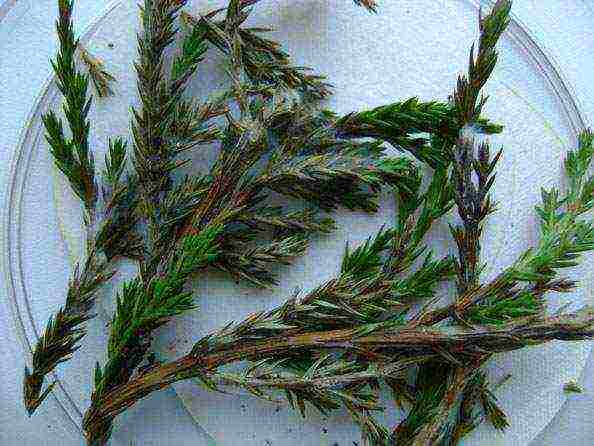 These factors are often the reasons for the negative impact of pathogenic infections, pathogenic microflora, pests. First of all, this is evidenced by yellowed, dying needles, after which the branches are damaged, and then the whole plant. Unfortunately, it is unlikely that it will be possible to save a bush with numerous clear signs of the disease.
These factors are often the reasons for the negative impact of pathogenic infections, pathogenic microflora, pests. First of all, this is evidenced by yellowed, dying needles, after which the branches are damaged, and then the whole plant. Unfortunately, it is unlikely that it will be possible to save a bush with numerous clear signs of the disease.
The affected branches must be pruned, destroyed, the remaining specimens must be carefully sprayed with fungicides. In the course of work, you need to use a pruner disinfected with alcohol.
For the needles, branches, fruits of the plant, the effect of the scale insect and its larvae is destructive. The juniper sawfly eats away the tissues of the bush from the inside. To get rid of pests, digging is carried out in the area of the trunk circle. Shoot moth caterpillars pose a danger to young branches.To destroy them, you will need to spray the juniper with insecticides.
The benefits of a plant for humans
 People have long paid attention to the useful properties of this representative of the Cypress family. The presence of juniper in the apartment will contribute to the creation of a unique atmosphere of comfort. Households who inhale its pine scent will certainly feel calm, and their sleep will become pleasant and strong.
People have long paid attention to the useful properties of this representative of the Cypress family. The presence of juniper in the apartment will contribute to the creation of a unique atmosphere of comfort. Households who inhale its pine scent will certainly feel calm, and their sleep will become pleasant and strong.
The cone berries of the plant contain a huge amount of healing substances, due to which they are used to prepare various healing decoctions and potions. In particular, the correct use of drugs based on them helps to improve the functioning of the urinary tract.
With the help of juniper resins, a whole range of skin diseases can be cured.  Taking drugs based on branches, needles of a plant will help in the fight against a number of ailments of viral origin.
Taking drugs based on branches, needles of a plant will help in the fight against a number of ailments of viral origin.
The intake of fresh berries relieves the condition of a large, suffering from stomach ulcers. The use of a decoction prepared from them makes it possible to cure liver diseases, rheumatism. Since ancient times, breastfeeding mothers have used juniper tincture to increase milk lactation.
Growing a juniper at home will be a lot of fun. The contemplation of this beautiful plant will bring aesthetic pleasure, and its wonderful aroma will contribute to the improvement of the atmosphere of the home. We advise you to view the article: Planting cherries with the main methods and rules for caring for it.
Juniper does not tolerate high temperatures and dry air. Placed in a hot room with central heating, it will quickly perish. But in a cool and bright room at a temperature of 10 ° C it winters well. Ideal if the balcony is turned into a miniature winter garden. If the temperature on the balcony, even in the most severe frosts, is above zero, not only juniper, but also many subtropical plants will be able to winter here (most of them need a temperature of 12 ° C for wintering). But such conditions are not always possible.
When placing a juniper in an apartment, choose the coolest windowsill for it and isolate the plant pot from the hot air of the room with plastic wrap. One side of it is fixed along the window sill, the other - above the plant along the window. But in any case, do not cover the plant completely, without cracks. Air access must be available. Chinese juniper (Juniperus chiensis L) is most suitable for placement in the house. This species requires mild wintering conditions, in the open field it often freezes under the weather, especially in the first years of life. It tolerates city conditions better than other species, but does not tolerate dry air. Very slow growth allows you to maintain a neat and compact shape for a long time.
Decorative dwarf forms of Chinese juniper are very good: "Alba" - with gray-white needles, "Aurea" - with golden needles, "Japonica Aureo-variegata" - with golden-variegated needles.
Juniper is a coniferous plant of the Juniperus subfamily of the Cupressaceae family. Depending on the taxonomic subdivision, there are about 50-67 species of juniper, which is widespread throughout the northern hemisphere, from the Arctic to the south to tropical Africa and the mountains of Central America.
Junipers vary in size and shape, from tall trees (20-40 meters in height) to low-spreading branched shrubs. It is an evergreen plant with needle leaves or scaly needles. The female cones are distinguished by their appearance, with fleshy, scales gathered together like a berry. The fruit of a juniper reaches 4-27 millimeters in length, it contains from one to twelve uncoated heavy seeds. In some species, these "berries" can be reddish brown or orange, but most of them are blue in color. They usually have a pleasant aroma, which is why they are used as a spice.The ripening time of the fruit can be from 6 to 18 months after pollination. Male cones are similar to similar fireweed fruits; consist of 6-20 scales. In most species, pollination occurs in the spring, although in some species, pollination occurs in early autumn.
Many junipers (including J. chinensis, J. virginiana) have two types of leaves: young shoots and some branches of old trees are covered with needles 5-25 millimeters in length, while mature trees are covered with needles, similar to scales, the size of each leaf is from 2 to 14 millimeters. Young leaves provide shaded areas, while mature foliage requires bright light.
The tree's therapeutic properties come from the volatile compounds contained in the plant's berries. These oils contain terpenes, glycosides of tannins, flavonoids, sugars and other substances. The diuretic component of juniper stimulates the kidneys, increasing their ability to filter fluids. The resins contained in juniper are beneficial in reducing skin problems such as psoriasis, and flavonoids help prevent viral diseases.
For more than three hundred years, juniper berries have been known as a popular gin flavor. Even the very name of the drink originated from the Danish "jeniver" - that was the name of the juniper there. The ancient Egyptians used juniper infusion as a means of increasing lactation as early as 1500 BC.
Junipers are grown at home either as a standalone plant or as material for bonsai. In the latter case, even in young plants, the top layer of the bark is removed, so that it appears white. Visually, you get the impression of an old tree that has transferred a lot, so the juniper is usually planted on stones to create an entourage.
The juniper tolerates temperature fluctuations well, but does not like high humidity, therefore, in order to avoid problems with the plant (up to the dropping of leaves) and root diseases, the juniper does not need to be watered intensively. Another requirement for the normal existence of a juniper is an abundance of air.
Juniper pruning is carried out annually at the end of the winter period, which is also a period of intensive plant growth. At this time, it is good to transfer to another container. By the way, once every few years, during transplantation, it is also necessary to trim the rhizomes.
If you decide to fertilize your juniper, use a minimum of fertilizer. Under adequate conditions, the plant itself develops quite well without additional fertilizing.
Juniper propagates with the help of cones and shoots. Planting shoots is of higher priority, since seed germination can last up to tens of years.
The juniper shrub that we grow in our gardens is a shrub with a height of 1 to 3 m, although sometimes gardeners prefer to grow tree-like forms of a plant - the height of a tree-like juniper is from 4 to 8, and sometimes up to 12 m.The stem is erect, branched. The bark of young plants is reddish-brown, old juniper usually has a brown bark. Juniper leaves are acicular or scaly, collected in whorls of several pieces. Juniper is a dioecious plant: female cones, fragrant with a spicy sweetish taste, have a diameter of 5 to 9 mm, an oval shape and a green color. Male cones look like elongated oval spikelets of bright yellow color, located in the axils of the leaves. Pine berries ripening in the second year, in which there are a dozen juniper seeds, have tightly closed fleshy scales.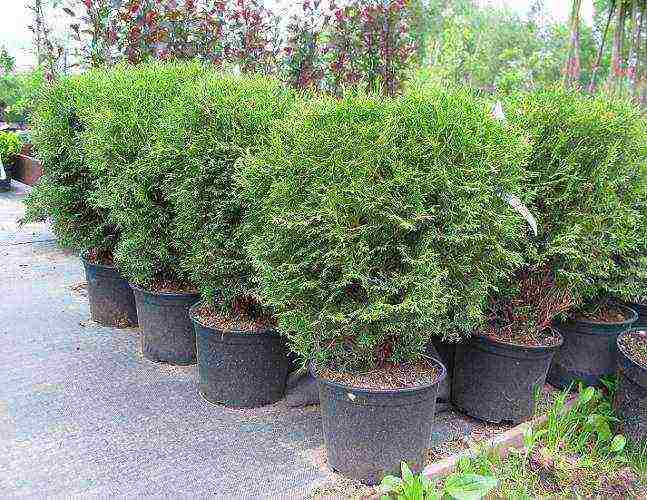
Types of juniper for home cultivation
Plants of the genus juniper can be grown not only in personal plots, but also at home, forming them into a standard dwarf tree or bonsai.In this case, the top layer of bark is removed from young plants, and visually the impression is created of an old tree that has seen a lot in its lifetime. To enhance the effect, bonsai are usually planted on stones, creating an appropriate entourage. The crown of the required shape is formed with the help of wire, branches that are too long should be cut off (pruning is best done with the onset of spring).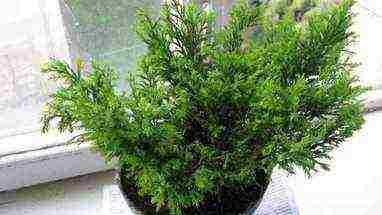
Decorative juniper is able not only to please the eye, but also, possessing strong bactericidal properties, purify the air for several meters around. However, when growing a juniper at home, do not forget that these plants do not tolerate dry air and high temperatures. If the indoor juniper is in a hot room, it will quickly die. For this reason, it is extremely important to create comfortable conditions to which plants of this genus are accustomed in nature - to provide access to light, maintain a sufficiently low temperature in winter, and regularly ventilate the room. For cultivation at home, Chinese juniper (Juniperus chiensis) is best suited. Of all the plants of the juniper genus, it requires milder wintering conditions, being in the cold season in the open field, it often freezes, especially for young seedlings. The extremely slow growth of Juniperus chiensis allows you to maintain the compact, neat shape of a houseplant for a long time. Dwarf forms of the Chinese juniper Japonica Aureo-variegata (shrub with golden-variegated needles), urea (with golden needles) and Alba (with white needles) are especially good for ornamental planting at home. Solid juniper (Juniperus rigida) is also suitable for indoor cultivation. Like the Chinese juniper, it grows extremely slowly and is long-lived. With the onset of cold weather, a decorative home juniper, a photo of which is widely presented on this page, is best kept in a winter garden, on a loggia or balcony. In this case, the plant will be provided with the necessary temperature regime and sufficient air access. Moreover, not only a decorative juniper, but also other indoor plants can winter in such conditions, because for the wintering of most of them the temperature should not exceed + 12 ° С.
Fresh articles about garden and vegetable garden
Reproduction of juniper
Juniper propagates in 2 ways: with the help of seeds; cuttings.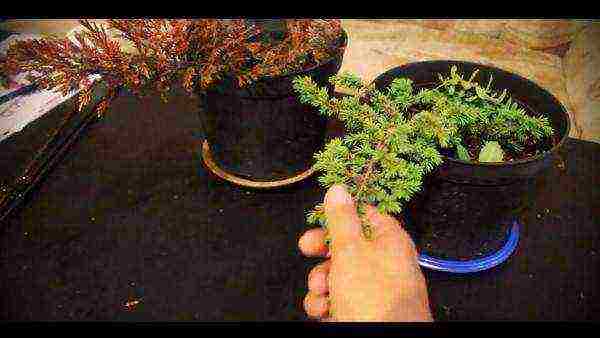
Seed breeding method
It is quite difficult to grow a plant from seeds, since it has poor germination. But if you do decide to grow a shrub at home from seeds. Then in this case, you need to plant a juniper in the autumn in boxes. During cold weather, the boxes should be taken outside, where they should stand for 4 months. The seeds preserved after the cold weather are planted in pots at the end of spring and continue to be stored in the fresh air. Usually, seedlings can be seen only the next year after planting the seeds. It is not easy to grow junipers from seeds at home, but if you create favorable conditions, then it is quite possible. In order for the plant to grow and develop perfectly, then the earthen coma should not be allowed to dry out. It is necessary to put a shrub in a well-lit place, and apply special fertilizers. Cutting method
Reproduction of a juniper at home using cuttings is easier than using seeds. But in order to carry out this procedure, the plant must be at least 8 years old. In the spring it is required to cut a stalk 10 cm long. Then it is placed in peat with sand, placed in a shaded place and covered with a film. The shrub must be constantly sprayed. After 2 months, roots will appear. It is during this period of time that the juniper needs to be transplanted.
Planting juniper in the room
When planting and growing a juniper at home in a pot, you must remember the following recommendations: For a plant, it is better to choose a free pot. Junipers grow well when there is plenty of room for the root system. At the bottom of the pot, there must be a drainage layer (broken brick, gravel, sand or expanded clay). Try not to let the soil dry out, and be sure to drain excess water from the pan. In indoor conditions, dry and hot air becomes the greatest danger for junipers.
Many beginner flower growers believe that the juniper is not whimsical at all to the soil. But this is not entirely true, before planting juniper in the ground, it is necessary to add a nutrient mixture. The composition of such a mixture includes sod land, peat and sand. In addition, it is advisable to add 200 g of nitrophosphate and any universal fertilizer to the soil (can be purchased at a flower shop). Juniper planting is carried out only in a pot with an additional layer of drainage at its bottom. Make a hole in a pot with pre-prepared soil 2 times the depth of the entire plant. If the root system of the juniper contains an earthen ball, make sure that when planting it is 8 centimeters above the bottom of the planting hole. Hold the plant and gently cover the hole with soil. After that, lightly tamp the topsoil and sprinkle it with mulch (you can use humus or peat).
Juniper care at home
Fresh articles about garden and vegetable garden
When growing a juniper at home in a pot, the following recommendations must be taken into account: It is better to choose a pot for the plant free. Conifers do well when there is room for the root system. Juniper is unpretentious to the composition of the soil. But you definitely need drainage at the bottom of the pot. And the soil can be taken like this - leafy earth, humus and sand in a ratio of 2: 2: 1. The plant loves light, but protection from direct sunlight is required, so it is undesirable to place it near windows facing the sunny side. The biggest danger to junipers at home is dry, hot air. Central heating in winter is detrimental to him. The best place for wintering is a warmed loggia or a cool window sill near the window glass. Recommended temperature regime in winter is 7-10 0C. In summer, the plant will feel best in the shade on the balcony.
It is useful to spray the plant daily, twice in the summer, in the morning and in the evening. There are both drought-resistant types of juniper and those that love moisture, but general recommendations are not to allow the soil to dry out, but it is also imperative to drain excess water from the pan after watering. Water in summer 2-3 times a week, in winter, in cool conditions of a loggia or a heated balcony, up to 3 times a month. The right time for transplanting juniper is March or November. During the growing season, it is recommended to feed the plant with fertilizers for conifers. Junipers rarely get sick at home, various fungal infections are characteristic of plants in the garden. If it became noticeable that the needles turn yellow, dry out, most likely, this is due to the dry warm air in the room or the scorching sun rays. It is urgently necessary to find a new habitat for the plant in the house, and cut off the damaged dry branches.
Plants of the genus juniper can be grown not only in personal plots, but also at home, forming them into a standard dwarf tree or bonsai. In this case, the top layer of bark is removed from young plants, and visually the impression is created of an old tree that has seen a lot in its lifetime. To enhance the effect, bonsai are usually planted on stones, creating an appropriate entourage. The crown of the required shape is formed with the help of wire, branches that are too long should be cut off (pruning is best done with the onset of spring).
Decorative juniper is able not only to please the eye, but also, possessing strong bactericidal properties, purify the air for several meters around. However, when growing a juniper at home, do not forget that these plants do not tolerate dry air and high temperatures. If the indoor juniper is in a hot room, it will quickly die. For this reason, it is extremely important to create comfortable conditions to which plants of this genus are accustomed in nature - to provide access to light, maintain a sufficiently low temperature in winter, and regularly ventilate the room.
For cultivation at home, Chinese juniper (Juniperus chiensis) is best suited. Of all the plants of the juniper genus, it requires milder wintering conditions, being in the cold season in the open field, it often freezes, especially for young seedlings. The extremely slow growth of Juniperus chiensis allows you to maintain the compact, neat shape of a houseplant for a long time.
Dwarf forms of the Chinese juniper Japonica Aureo-variegata (shrub with golden-variegated needles) are especially good for ornamental planting at home,
Aurea (with golden needles)
and Alba (with white needles).
Solid juniper (Juniperus rigida) is also suitable for indoor cultivation. Like the Chinese juniper, it grows extremely slowly and is long-lived.
With the onset of cold weather, a decorative home juniper, a photo of which is widely presented on this page, is best kept in a winter garden, on a loggia or balcony. In this case, the plant will be provided with the necessary temperature regime and sufficient air access. Moreover, not only a decorative juniper, but also other indoor plants can winter in such conditions, because for the wintering of most of them the temperature should not exceed + 12 ° С.
Indoor juniper and plant care
Caring for a juniper at home is not difficult, but remember that it does not tolerate stagnant moisture. For this reason, in order to avoid problems (root diseases, leaf fall), plants do not need to be watered too intensively and try to create good air circulation in the room.
Pruning of indoor juniper, like other plants of this genus growing in open ground, is carried out annually at the end of the winter period. At this time, there is an intensive growth of ornamental shrubs, so it makes sense to transplant the plant into another container. Sometimes (no more than once every three to four years) it is necessary to trim the rhizome.
When growing a decorative juniper (see photo) in an apartment, you should choose the coolest windowsill for it. If there is a heating source nearby (battery, heater, etc.), the bonsai flowerpot must be fenced off from the hot air with plastic wrap. To do this, one side of the cellophane covering is fixed along the window sill, and the other is attached over the plant along the window. However, in no case should the plant be completely closed - it is necessary to leave several slots for free air access.
Caring for indoor juniper involves creating conditions close to natural for the plant. It is necessary to choose a sufficiently illuminated place without prolonged exposure to direct sunlight, to ensure sufficient air circulation and the absence of stagnant moisture. In summer, the air temperature should not exceed + 20 ° C; it is useful to periodically expose the plant to the air. The optimum air temperature in winter is from + 10 to + 12 ° C. Since junipers do not tolerate air pollution, the crown of ornamental plants should be regularly sprayed. In winter, the plant should be kept as close to the window as possible, and even better - on the loggia or balcony, providing the required minimum temperature.In the cold season, watering ornamental shrubs should be done as rarely as possible.
Homemade juniper needs a little feeding. It is preferable to use organic fertilizers, for example, humus. Occasionally, you can add mineral fertilizers, but in this case you should not overdo it - feeding is done only in summer and in small quantities.
Young indoor junipers should be replanted once a year, in the spring. Old plants do not need frequent replanting, but it is advisable to replace the topsoil annually. Do not forget about drainage, and the land should consist of a sod-peat mixture with the addition of sand. If a solid or Cossack juniper is grown at home, a little lime must be added to the soil, and a small part of the clay is needed to grow Virginia juniper.
